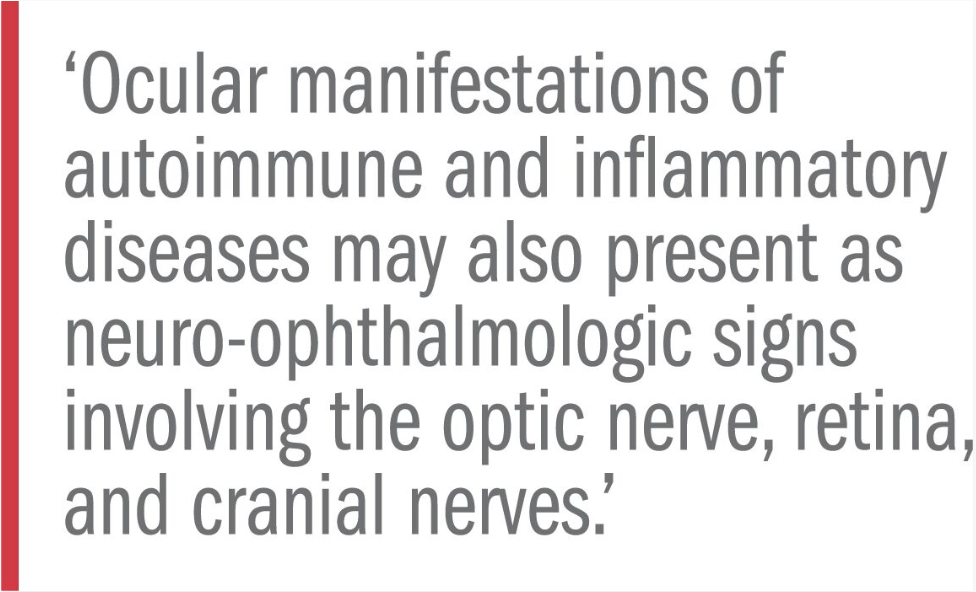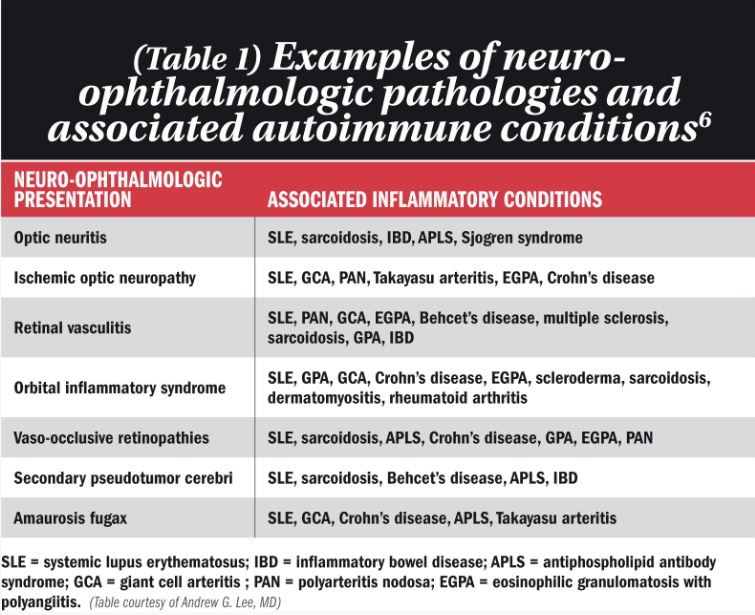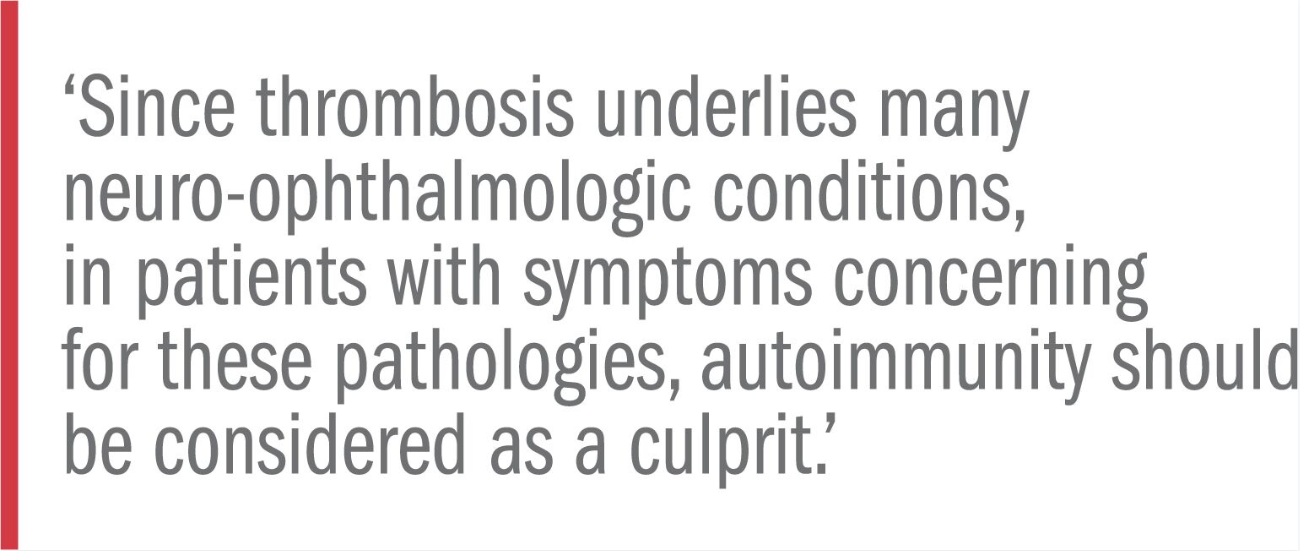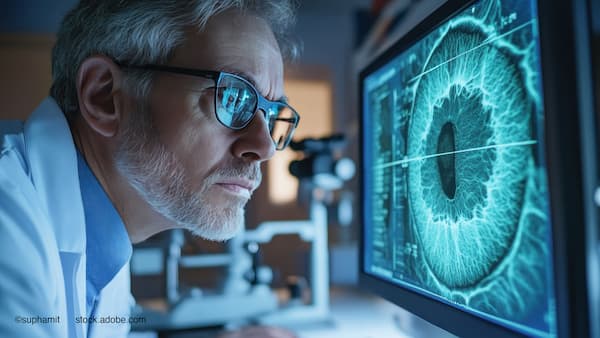Article
When autoimmune diseases exert neuro-ophthalmic effects
Author(s):
Treatment should focus on the underlying etiology behind these processes


The Neuro-Connection
While the targets and mechanisms of systemic inflammatory diseases are variable, many of these diseases share similar manifestations in the eye. Therefore, through the course of these autoimmune conditions, it is imperative to keep in mind the potential ocular ramifications associated with these diseases.
Whether directly through immunologic mechanisms, or indirectly through the development various pathologic states such as hypertension, hypercoagulability, arteritis, and mass effect, autoimmune diseases have significant potential to threaten patients’ vision.

When ocular or orbital disease is detected in patients with autoimmune conditions, ophthalmologists should consider a differential diagnosis with the inflammatory state in mind.
While the involvement of the uvea and cornea is usually more common than the posterior segment, ocular manifestations of autoimmune and inflammatory diseases may also present as neuro-ophthalmologic signs involving the optic nerve, retina, and cranial nerves.
These pathologies can include, but are not limited to optic neuritis, a spectrum of ischemic optic neuropathies (arteritic anterior ischemic optic neuropathy, non-arteritic anterior ischemic optic neuropathy, posterior ischemic optic neuropathy), orbital inflammatory syndrome, retinal vasculitis, retinal vein occlusions, retinal artery occlusions, secondary pseudotumor cerebri, and symptoms such as amaurosis fugax. Numerous reports of autoimmune diseases associated with these pathologies have been described (see Table 1).
The mechanisms through which autoimmune diseases exert neuro-ophthalmologic effects are numerous but may include immune-mediated demyelination,1 vasculitis,2 vasospasm,3 immune complex deposition, 4 and hypercoagulability.5
In recent studies, the mechanisms underlying hypercoagulability in autoimmune disease have been further elucidated. Systemic inflammation has been shown to increase thrombotic processes through the suppression of fibrinolysis, upregulation
of procoagulants, downregulation of anticoagulants, and genesis of pathogenic antibodies (e.g. lupus anticoagulant, anti-cardiolipin, and anti-B2 glycoprotein 1).5
In light of these mechanisms, autoimmune disease may be considered a hypercoagulable state, thus explaining why numerous autoimmune diseases such as systemic lupus erythematosus, inflammatory bowel disease, and Behcet’s syndrome have been shown to confer a high risk of venous thromboembolism.5
Since thrombosis underlies many neuro-ophthalmologic conditions, in patients with symptoms concerning for these pathologies, autoimmunity should be considered as a culprit.
In conclusion, in patients with history of autoimmune disease that present with neuro-ophthalmologic signs and symptoms, after pertinent workup, treatment should focus on the underlying etiology behind these processes.
Patients with acute neuro-ophthalmic presentations who have active systemic autoimmune disease might require hospital admission, urgent neuroimaging and systemic evaluation, high-dose intravenous corticosteroids, or additional immunosuppressive or disease modifying rheumatologic drugs.
Disclosures:
Iyza F. BaigE: iyza.baig@uth.tmc.edu
Braig is affiliated with the McGovern Medical School at The University of Texas Health Science Center in Houston (UTHealth), Houston.
Aroucha Vickers, DOE: aroucha.vickers@gmail.com
Vickers is affiliated with the Department of Ophthalmology, Blanton Eye Institute, Houston Methodist Hospital, Houston.
Andrew G. Lee, MDE: aglee@houstonmethodist.org
Dr. Lee is affiliated with the Department of Ophthalmology, Blanton Eye Institute, Houston Methodist Hospital, Houston; Baylor College of Medicine, Houston, TX; Adjunct Professor of Ophthalmology; and Departments of Ophthalmology, Neurology, and Neurosurgery, Weill Cornell Medical College, Houston; Clinical Professor, UTMB Galveston, TX and the UT M.D. Anderson Cancer Center, Houston; Adjunct Professor of Ophthalmology, The University of Iowa Hospitals and Clinics, Iowa City, IA.
None of the authors indicated a proprietary interest in the subject matter.
References:
1. Toosy AT, Mason DF, Miller DH. Optic neuritis. The Lancet Neurology. 2014;13: 83-99.
2. McCluskey P, Powell RJ. The eye in systemic inflammatory diseases. The Lancet. 2004;364: 2125-2133.
3. Flammer J, Pache M, Resink T. Vasospasm, its role in the pathogenesis of diseases with particular reference to the eye. Progress in Retinal and Eye Research. 2001;20:319-349.
4. Aronson AJ, Ordonez NG, Diddie KR, Ernest T. Immune-complex deposition in the eye in systemic lupus erythematosus. Arch Intern Med. 1979;139:1312-1313.
5. Zöller B, Li X, Sundquist J, Sundquist K. Autoimmune diseases and venous thromboembolism: a review of the literature. American Journal of Cardiovascular Disease. 2012;2:3:171.
6. Baig IF, Vickers A, Lee AG (2018). Ophthalmologic Manifestations of Autoimmune Disease. [online] Eyewiki. Available at: http://eyewiki.org/ Ophthalmologic_Manifestations_of_ Autoimmune_Diseases
Newsletter
Don’t miss out—get Ophthalmology Times updates on the latest clinical advancements and expert interviews, straight to your inbox.





